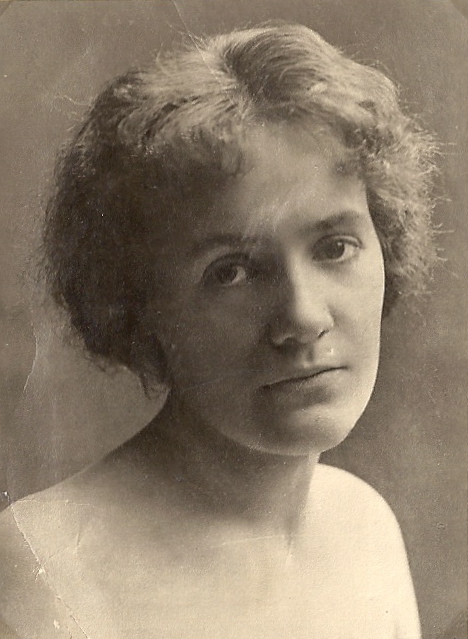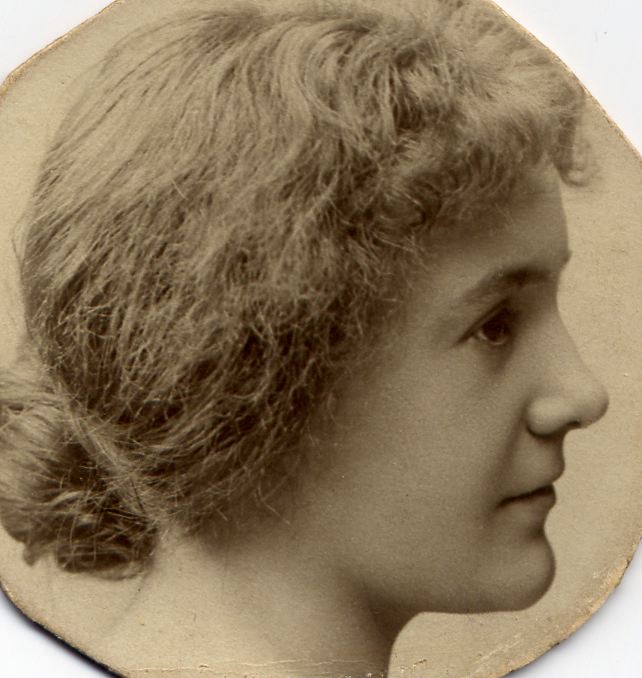Ebba Lindkvist (also spelled or referred to as Ebba Lindqvist or Ebba Bergman, 1882–1942), had a long professional life within the theatre as both actor and educator. In October 1910 she directed the second film version of the year of F A Dahlgren’s well-known humorous drama “Värmlänningarna” (“The Warmlanders”). Carl Engdahl had already directed a production of the same name for Svenska Bio, which had its premiere in January. Thus, Ebba Lindkvist was active as a director before Anna Hofman-Uddgren, who is usually regarded as Sweden’s first female film director, although Lindkvist’s achievement is not characterized by Hofman-Uddgren’s professionalism. She played in the film herself (which is usually spelled Värmländingarna); but besides another film role for the same company – Malmö producer Frans Lundberg – this was to be her only contribution to Swedish cinema.
Not least due to this fact, it is worthwhile to go into detail about the weight of this quite particular directing credit. This did not happen until after a local new item in the Malmö daily Sydsvenska Dagbladet 1972, which called for information on the film shoot. [1] The lead role performer Ester Selander got in touch and helped putting together a cast list. She recounted that a stage production formed the basis for the film and that Ebba Lindkvist “was as close as anything to be considered as the director”. [2]
Ebba Lindkvist had a lifelong close professional relationship with her husband Victor, who was also involved in the stage production as well as the film shoot. To automatically assume that female performers who have been married to other performers in their achievement must have leaned on their spouse is of course a cliché to be wary of, on the other hand, it is surprisingly common. This could easily have been the case with Värmländingarna as well – but since Victor suffered from a severely impaired vision, it seems unreasonable that he could have exercised any direction in this to him brand new medium.
The term “directing” should here be regarded as actor directing. At this time, film workers were still credited sparingly, and there was no director role with the same meaning as in subsequent films. On the other hand, Ebba and Viktor Lindkvist probably directed the theatre performance that formed the basis for the film. As Jan Olsson has described, the play was given during three Sundays in August 1910 at the Fågelsång Tivoli outside of Lund. [3] Ebba and Victor Lindkvist had borrowed the summer-vacationing ensemble from the Folkets hus theatre in Malmö. Many filmmakers of the time often did exactly the same thing and contracted theatre actors during their summer holidays.
At the Folkets hus theatre, the “Värmlänningarna” was regularly performed before, as well as after the filming took place, making the play very familiar to the ensemble. [4] For a long time it was one of Sweden’s most performed plays; in the Stockholm daily Svenska Dagbladet’s review of the summer season’s repertoires in 1909, they declared it “our most popular theatre play”. [5] Victor in particular had ties to the Folkets hus theatre: he wrote revues and comedies for that very stage and had previously also been part of the ensemble. [6] By and large, the Fågelsång staging seems to have been converted into film.
If Ebba Lindkvist was responsible for directing the actors, the images are highly likely courtesy of cinematographer Ernst Dittmer. Dittmer most recently came from Svenska Bio in Kristianstad, where he was the second photographer for Carl Englund’s earlier film version (which is usually spelled Värmlänningarne). One may assume that his experiences of that production came quite handy in this version a few months later. [7] How closely the technical and aesthetic solutions resemble or differ from Englund’s previous film can no longer be determined – only Englund’s film has survived; of Lindkvist’s film, only a few minutes still exist. A few still images from the film programme are however available and can at least give an impression of the film.
Ebba Lindkvist’s Värmländingarna would otherwise have a somewhat unusual circumstance. Frans Lundberg had made short film recordings of song numbers from the play, and in decent sync with the sound, completely in line with the entertainment trends of the time. By incorporating these into the feature film, a version with synchronized song numbers could be shown in Helsinki. [8]
The essentials of Ebba Lindkvist’s biography are well documented by her family. She was born in Stockholm on March 10, 1882. Her parents were Emma Augusta Charlotta, born Brobeck, and Gustaf Edvard Bergman. Her father was a master tinsmith, and his obituary describes him as active in the Folkets hus, the union and the social democracy. Ebba was the second child out of four.
The obituary in Sydsvenska Dagbladet reports that Ebba Lindkvist in her youth conducted “extensive studies” for Bertha Tammelin and for Emil Hillberg. [9] Both of them were central forces in the dramatic pedagogy in Stockholm. Actress Bertha (Bock) Tammelin was active at the Royal Theatre’s student school and was as teacher best known for her speech pedagogy. [10] Emil Hillberg was behind the well-known experiment of Sydsvenska Skådebanan (“The Southern Swedish Arena”), where theatre students learned by practicing on tour in southern Sweden. [11] The trial did not work out very well and nine of the young actors had to be left behind in Malmö in January 1902 – among others the then-named Ebba Bergman.[12] In the repertoire of this company, one of the plays performed was indeed “Värmlänningarna”.
In this unexpected way Ebba Bergman arrived in the province of Skåne/Scania, where she would mainly live for the rest of her life. In letters and postcards preserved by her family the mobility of Ebba and her acting colleagues during their young years was quite vivid. According to the correspondence, she for example worked at the municipal theatre in Lund. She married Victor Lindkvist in Malmö on May 15, 1907. In addition to raising three children, the couple also performed dramatic educational activities together from 1910 and onwards. [13] In a poem written – and with all certainty presented to her – by her husband on her 41st birthday in 1923, it says (loosely translated):
You have been known both here and there
For teaching skills in speaking fair
Good manners, too, with thespian flare…
If the dramatic teaching was perceived as the core business, the bread and butter work seems to have been speech therapy for children. For example, a few years later, the Swedish teacher magazine included both an editorial note and an advertisement about the song and speech school. The legacy of Bertha Tammelin was thus transposed to a wider public, as seen in the advertisement: [14]
In speech technology, tone formation and solo singing as well as hygienic voice care for hoarse, tired and overworked speech organs, longer or shorter courses are given during the holidays. All teaching individually conducted with each student. Stuttering and other speech impediments are dealt with. Lower fees for school children. Ebba and Victor Lindkvist. Per Vejersgatan 8, Malmö. Tel. 66 84.
According to their family, Ebba and Victor Lindkvist moved to their son Rudolf in Växjö during World War II, in order to move further away from Denmark and the war. Ebba Lindkvist died at the Växjö hospital in the suites of pneumonia on June 5, 1942. It would take another thirty years before she got the epithet of film director.
In 2016 Ebba Lindkvist got the Ebba award named after her. The award was instituted by Skåne’s film festival Pixel and is awarded to a female director, photographer, scriptwriter or editor residing in Skåne.
Anne Bachmann
(Translated by Jan Lumholdt)
Translator’s notes:
“Värmlänningarna” – “The Warmlanders” – written in 1845 by Fredrik August Dahlgren, takes place in the province of Värmland and is the story of the well-to-do young Erik who is betrothed to a posh girl but in love with Anna, a crofter’s daughter. After some dramatic incidents (they almost drown), the joyful marriage feast is celebrated as the two now are united. There have been five adaptations for screen or television and countless stage productions, including an Ingmar Bergman one at Malmö’s municipal theatre in 1958. It is also popular among amateur groups, as can be seen in Arne Mattsson’s One Summer of Happiness (1951), where a youth club puts it on in a countryside barn. Among the play’s songs are “Värmlandsvisan” (“The Warmland Song”), which, as “Dear Old Stockholm”, became a popular international jazz standard, performed by Stan Getz, Miles Davis and many others.
Folkets hus – “The People’s House” – is a Swedish social democrat institution of the late 19th century and onwards, a locality where meetings could be held and assorted cultural events could take place. Especially between 1900 and the 1970s, they were lively venues.
Selected literature
Kjellgren, Lennart. Skojarna på Skolgatan: en rapsodi kring Folkets hus teater 1893–1947. Malmö: Fören. för scen- och manegemuseum, 1992
Olsson, Jan. Sensationer från en bakgård: Frans Lundberg som biografägare och filmproducent i Malmö och Köpenhamn. Lund: Symposion, 1989
Olsson, Jan. Från filmljud till ljudfilm: samtida experiment med odödlig teater, sjungande bilder och Edisons kinetophon 1903–1914. Stockholm: Proprius, 1986
Endnotes
[1] Lars Lindström, ”Suddiga bilder av malmöitiska Värmlännigar [sic]”, SDS 3 september 1972, s. 14.
[2] Punkt (Ragnar Gustafsson), ”Ett samtal med Anna”, SDS 5 september 1972, s. 12.
[3] Jan Olsson, Sensationer från en bakgård: Frans Lundberg som biografägare och filmproducent i Malmö och Köpenhamn. Lund: Symposion, 1989, ss. 80–82.
[4] Lennart Kjellgren, Skojarna på Skolgatan: en rapsodi kring Folkets hus teater 1893–1947. Malmö: Fören. för scen- och manegemuseum, 1992, appendix.
[5] Okänd, ”Teatersäsongen i landsorten”, SvD 11 oktober 1909, s. 8.
[6] Kjellgren, ss. 27, 12.
[7] Olsson, Sensationer från en bakgård, s. 18.
[8] Jan Olsson, Från filmljud till ljudfilm: samtida experiment med odödlig teater, sjungande bilder och Edisons kinetophon 1903–1914. Stockholm: Proprius, 1986, ss. 124–131.
[9] Dödsruna, SDS, 6 juni 1942, s. 7.
[10] Håkan Åbrink, ”Om teatersvenska som målspråk vid början av 1800-talet”. I Studier i svensk språkhistoria 12: Variation och förändring, red. Maria Bylin, Cecilia Falk och Tomas Riad. Stockholm: Acta Universitatis Stockholmiensis, 2014, ss. 252–261.
[11] ”C W Emil Hillberg”, fast länk urn:sbl:13597, Svenskt biografiskt lexikon (artikel av Stig Torsslow), hämtad 2016-05-02.
[12] Arne Lindenbaum, ”Emil Hillberg och Sydsvenska Skådebanan”, SDS, 11 april 1948, s. 4.
[13] Årtalet enligt Victor Lindkvists dödsruna i SvD, 5 juli 1957, s. 10.
[14] Svensk läraretidning: Illustreradt veckoblad för folkundervisningen, 49:e årg., nr. 24, 11 juni 1930, ss. 577 och 572.
Basic info
Main profession: Director
Born: 1882
Died: 1942
Active: 1910-1911
Filmography
Regi:
Värmländingarna (1910)
Roll:
Rannsakningsdomaren (1911)
Värmländingarna (1910)

